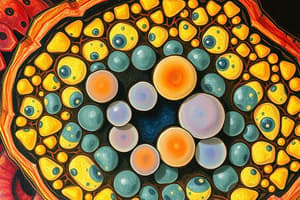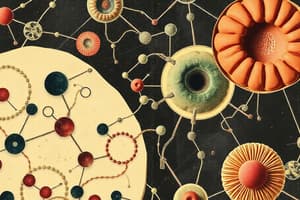Podcast
Questions and Answers
What is the primary function of the cell nucleus?
What is the primary function of the cell nucleus?
What is the origin of chloroplasts?
What is the origin of chloroplasts?
What is the result of the light-dependent reactions in photosynthesis?
What is the result of the light-dependent reactions in photosynthesis?
What is the purpose of chlorophyll in chloroplasts?
What is the purpose of chlorophyll in chloroplasts?
Signup and view all the answers
What is the Calvin cycle responsible for?
What is the Calvin cycle responsible for?
Signup and view all the answers
What is the result of the light-independent reactions in photosynthesis?
What is the result of the light-independent reactions in photosynthesis?
Signup and view all the answers
Why are chloroplasts essential for plants and photosynthetic algae?
Why are chloroplasts essential for plants and photosynthetic algae?
Signup and view all the answers
What is a characteristic of chloroplasts that is similar to solar panels?
What is a characteristic of chloroplasts that is similar to solar panels?
Signup and view all the answers
What is the primary source of energy for Rafflesia?
What is the primary source of energy for Rafflesia?
Signup and view all the answers
What is the purpose of stomata in most plants?
What is the purpose of stomata in most plants?
Signup and view all the answers
What is the byproduct of carbon fixation in plants?
What is the byproduct of carbon fixation in plants?
Signup and view all the answers
Where was CAM metabolism first discovered and studied?
Where was CAM metabolism first discovered and studied?
Signup and view all the answers
What is the primary function of anabolism?
What is the primary function of anabolism?
Signup and view all the answers
What happens to the energy released during catabolism?
What happens to the energy released during catabolism?
Signup and view all the answers
What is the result of increasing ATP concentrations in the cell during catabolism?
What is the result of increasing ATP concentrations in the cell during catabolism?
Signup and view all the answers
Why do most plants open their stomata during the day?
Why do most plants open their stomata during the day?
Signup and view all the answers
Study Notes
Cell Nucleus
- The cell nucleus is a large organelle in eukaryotic organisms that protects most of the DNA within each cell.
- It produces precursors necessary for protein synthesis.
- The DNA housed within the cell nucleus contains information necessary for creating most proteins needed to keep a cell functional.
Chloroplasts
- Chloroplasts are found only in algal and plant cells and produce energy through photosynthesis.
- They have a high concentration of chlorophyll, the molecule that captures light energy, giving plants and algae a green color.
- Chloroplasts are thought to have evolved from once free-living bacteria.
- They are essential for the growth and survival of plants and photosynthetic algae.
Functions of Chloroplasts
- Chloroplasts carry out photosynthesis, converting light energy to energy stored in the form of sugar and other organic molecules.
- Photosynthesis has two stages: light-dependent reactions and light-independent reactions (Calvin cycle).
- In light-dependent reactions, chlorophyll and carotenoids capture sunlight to form ATP and NADPH.
- In the Calvin cycle, NADPH converts inorganic carbon dioxide to an organic molecule in the form of a carbohydrate (CO2 fixation).
- Carbohydrates and other organic molecules can be stored and used at a later time for energy.
Special Cases
- Rafflesia, a parasitic plant genus, has lost its chloroplasts and obtains its nutrients from other plants.
- CAM (Crassulacean Acid Metabolism) is a method of carbon fixation evolved by some plants in dry circumstances.
- CAM plants open their stomata at night to take in CO2 and release O2, reducing water loss.
Metabolism
- Catabolism is the part of metabolism responsible for breaking complex molecules down into smaller molecules.
- During catabolism, energy is released from the bonds of large molecules and stored in ATP.
- ATP concentrations increase as nutrients and food are broken down, making it more likely to be used for energy.
Studying That Suits You
Use AI to generate personalized quizzes and flashcards to suit your learning preferences.
Description
This quiz covers the structure and functions of the cell nucleus and chloroplast organelles in eukaryotic cells, including their roles in protein synthesis and photosynthesis.





